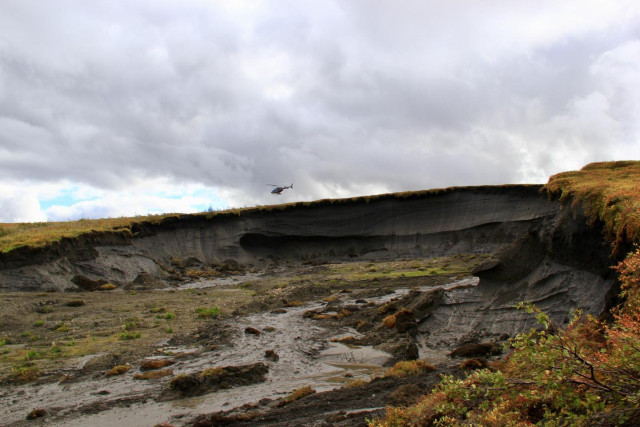
by Alisia Holland Friday, November 30, 2018

An area of permafrost collapse, called a thaw slump, on the Peel Plateau in Canada's Northwest Territories exposes buried minerals in long-frozen soil to the elements at the surface. Credit: Scott Zolkos
After warming the bench since the Pleistocene, a key player in the Arctic carbon cycle is getting back in the game thanks to thawing permafrost. In a new study, researchers report that rising temperatures are freeing sulfide minerals previously bound within Arctic permafrost. These minerals are contributing to stream acidification and accelerated weathering of carbonates — and thus to the release of carbon dioxide into the atmosphere — at least in one part of northern Canada.
Across much of the Arctic, carbonate minerals — scraped from bedrock and redeposited by Pleistocene glaciers — are abundant in permafrost soils. When areas of permafrost thaw, they can collapse, producing pockmarked landscapes and re-exposing the minerals to the elements at the surface. Carbonates are most commonly broken down, or weathered, via chemical reaction with carbonic acid, which forms when gaseous carbon dioxide in the atmosphere dissolves in rain or streamwater. Because carbon dioxide is consumed in this reaction, carbonate weathering via carbonic acid is considered a sink for atmospheric carbon dioxide.
However, “in the area where we work, on the Peel Plateau in the Northwest Territories of Canada, we find that thawing permafrost in this region of the Arctic is exposing both carbonates and sulfide minerals to weathering,” says Scott Zolkos, a graduate student studying biogeochemistry at the University of Alberta in Canada, and lead author of the new study in Geophysical Research Letters. “When that happens, it changes the chemistry of streams,” Zolkos says.
Sulfides exposed to oxygen at Earth’s surface are converted to sulfates, which then form sulfuric acid in water. Like carbonic acid, sulfuric acid reacts with and weathers carbonate minerals. However, unlike with carbonic acid, carbonate weathering by sulfuric acid does not consume atmospheric carbon dioxide; instead, it can actually release more carbon dioxide into the air. “The key is that … the sulfides generate some sulfuric acid that then weathers the carbonate minerals. This may enable carbon dioxide production,” Zolkos says.
To examine effects of permafrost thaw intensity and mineralogy on inorganic carbon cycling in the Arctic, Zolkos and his team analyzed water chemistry at 24 sites along eight streams affected by thawing permafrost just southwest of the town of Fort McPherson. Based on concentrations of sulfate, bicarbonate and other ions in the streams, as well as on carbon isotopic signatures in the water, they found that sulfuric acid is the dominant cause of carbonate weathering in the region (though evidence of carbonic acid weathering was found as well). This weathering, they noted, is likely contributing to the high levels of carbon dioxide production and outgassing observed in streams downstream from the permafrost.
The researchers also noted that long-term monitoring of ion concentrations in the nearby Peel River, conducted by other researchers, has indicated a correlation between increasing permafrost thaw in recent decades and increasing sulfate concentrations. Zolkos and his colleagues identified a 125 percent rise in the concentration of sulfate between 1979 and 2015, suggesting that sulfuric acid-driven carbonate weathering in the region has intensified over that period.
On a regional scale, Zolkos and his team calculated that the 70,000-square-kilometer Peel River watershed released as much as 240 million kilograms of carbon dioxide due to sulfuric acid weathering in 2015 alone. That is enough to offset about 20 percent of the estimated amount of atmospheric carbon dioxide consumed by carbonate weathering in the adjacent Mackenzie River watershed, which, at 1.8 million square kilometers, is more than 25 times the size of the Peel watershed. The researchers noted that mineral weathering processes like those they observed on the Peel Plateau may impact other areas of the Arctic, including parts of Siberia and Alaska, where sulfides and carbonates are present in thawing permafrost.
This study offers “an interesting quantification of the effect of mineral weathering on the balance of carbon dioxide” in permafrost systems, says Ted Schuur, an ecosystem ecologist at Northern Arizona University who was not involved in the work. Although much research has been done looking at the release of organic carbon stored in permafrost, the release of inorganic carbon from the thawing soils has not been given much attention. “The authors make an important point that the interactions with inorganic carbon have not been a focus of [study in] changing permafrost ecosystems,” Schuur says, adding that permafrost carbon “released by inorganic weathering is on the scale that makes it significant” in terms of potentially impacting climate.
© 2008-2021. All rights reserved. Any copying, redistribution or retransmission of any of the contents of this service without the expressed written permission of the American Geosciences Institute is expressly prohibited. Click here for all copyright requests.